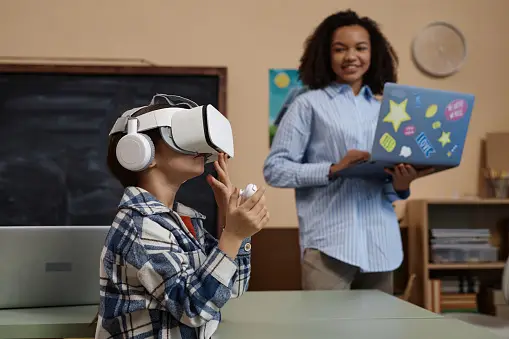Gamification in education refers to the incorporation of game design elements, game principles, and game-based thinking into educational environments and learning scenarios. This approach aims to enhance learner engagement, motivation, and participation by making learning experiences more interactive, rewarding, and enjoyable. Over the years, gamification has gained traction among educators, researchers, and developers, who see its potential to transform traditional learning methods and address various education challenges.
What Is Gamification in Education?
Gamification in education refers to the integration of game elements and principles into the educational environment to engage and motivate students to learn. This approach utilizes rewards, challenges, and interactive components to enhance student participation, understanding, and retention of information. By leveraging the intrinsic motivation that games provide, educators aim to foster a more engaging and dynamic learning experience.
Types of Gamification in Education
Gamification in education can take various forms, each designed to suit different learning objectives and environments. The most common types include:
- Point-Based Systems: Students earn points for completing tasks or achieving goals, often leading to rewards or recognition.
- Badge and Achievement Systems: Similar to points, badges are awarded for specific achievements, marking students’ progress and accomplishments.
- Leaderboards: These display rankings based on points or badges earned, fostering a healthy competitive environment.
- Story-Based Gamification: Incorporating narrative elements into the curriculum to create a storyline that progresses as students complete learning modules.
- Level-Up Mechanics: Students progress through different levels or stages, unlocking new content or challenges as they advance.
Gamification in Education Examples
Several practical examples highlight how gamification can be effectively implemented in education settings:
- Duolingo: This language learning app uses points, streaks, and levels to encourage daily practice.
- Classcraft: An educational platform that transforms the classroom into a role-playing game, where students undertake quests and earn rewards in a fantasy-themed narrative.
- Kahoot!: A game-based learning platform that allows educators to create quiz games for students, fostering interaction and competitive learning.
Pros of Gamification in Education
- Increases Engagement: Gamification makes learning more engaging by incorporating elements of fun and competition.
- Boosts Motivation: Rewards and achievements drive students to take initiative and strive for excellence.
- Enhances Learning Outcomes: Interactive and practical experiences improve knowledge retention and understanding.
- Promotes Collaboration: Many gamified activities require teamwork, enhancing communication and collaborative skills.
- Provides Instant Feedback: Immediate rewards or corrections allow students to understand their progress and areas for improvement.
- Adapts to Individual Learning Paces: Gamification can accommodate diverse learning speeds and styles, offering personalized paths to mastery.
- Fosters Creativity and Problem-Solving: Games often require creative thinking and strategy, skills valuable beyond the classroom.
- Reduces Anxiety: The playful aspect can lower stress associated with traditional assessments, making learning more accessible.
- Encourages Continuous Learning: The desire to progress and achieve can motivate students to pursue learning outside the classroom.
- Technology Integration: Gamification often involves digital tools, preparing students for a technologically advanced world.
Cons of Gamification in Education
- Overemphasis on Competition: Excessive focus on rewards can lead to unhealthy competition and stress among students.
- Potential for Distraction: Games might divert attention away from learning objectives, focusing more on winning than understanding.
- Unequal Participation: Students with less interest or ability in gaming might feel alienated or disadvantaged.
- Resource Intensive: Developing and implementing gamified content requires significant time, technology, and expertise.
- Superficial Learning: There’s a risk that students may memorize information for points rather than deeply understanding concepts.
- Privacy Concerns: Digital platforms used in gamification may raise issues regarding data privacy and security.
- Accessibility Issues: Not all students may have equal access to the necessary technology, widening the educational divide.
- Varied Efficacy: Gamification might not be equally effective for all subjects or learning objectives.
- Dependence on External Rewards: Students might become reliant on rewards for motivation, diminishing intrinsic interest in learning.
- Difficulty in Assessment: Measuring learning outcomes through gamification can be challenging, potentially complicating grading systems.
Conclusion
Gamification in education offers a novel approach to enhance learning experiences by making them more interactive, engaging, and enjoyable. While there are significant advantages, including increased motivation and improved learning outcomes, educators must also be mindful of the potential drawbacks, such as the risk of distraction and unequal participation. The key to successful implementation lies in striking a balance, ensuring that gamification serves as a tool to complement traditional teaching methods rather than replace them.
Frequently Asked Questions
Can gamification be applied to all subjects?
Yes, with creative design, gamification can be applied across various subjects, though its effectiveness may vary depending on the subject matter and learning objectives.
Is gamification suitable for all age groups?
Yes, gamification can be tailored to suit different age groups, with the complexity and type of game elements adapted to be age-appropriate.
How do educators measure success in gamified learning?
Success can be measured through traditional assessments, student feedback, engagement levels, and the achievement of specific learning objectives.
Does gamification replace the role of a teacher?
No, gamification is a tool to support educators, not replace them. Teachers play a crucial role in designing, implementing, and guiding the gamified learning experience.
How can schools overcome the challenges of implementing gamification?
Addressing challenges requires careful planning, including selecting appropriate technology, training educators, ensuring accessibility, and maintaining a focus on education objectives.




